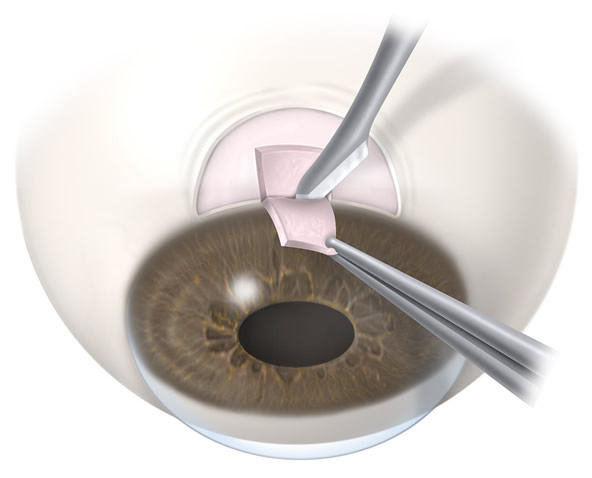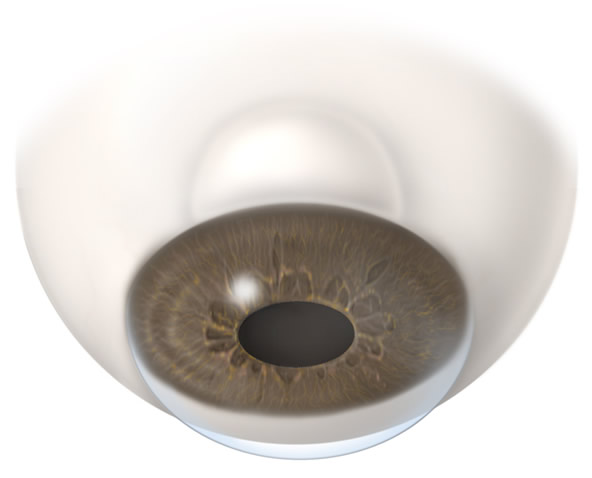Glaucoma Surgery: Trabeculectomy
Why do I need a Trabeculectomy?
A trabeculectomy is recommended to treat glaucoma when more conservative treatment such as medication or laser do not provide adequate pressure control. In glaucoma, eye pressure causes damage to the optic nerve. With damage to the nerve, there can be irreversible loss of vision, and sometimes blindness. Fortunately, there are many excellent treatments for glaucoma that can prevent or stop vision loss. Generally we start treatment with medicated eye drops. Patients are treated with one or more drops to lower eye pressure. Unfortunately, drops don’t always lower eye pressure enough to protect a patient from further nerve damage and vision loss. Sometimes laser is an option, but laser does not work for everyone, and may not lower pressure enough. For that reason, a trabeculectomy is often the next step in treatment of glaucoma.

What is a Trabeculectomy?
A trabeculectomy is a surgery designed to lower eye pressure to treat glaucoma. In a trabeculectomy, a new drain is created within the eye to allow fluid to leave the eye. This is done by removing a small piece of the natural drain in the eye and creating an opening in the sclera (the white of the eye) that is covered by a membrane on the surface of the eye (the conjunctiva). Fluid collects under the membrane (conjunctiva), forming a small elevation called a “bleb” that is under the upper eyelid. The fluid is then gradually absorbed into the body from the bleb.
What will I Experience During Trabeculectomy Surgery?
A trabeculectomy is an outpatient surgery. The eye is numbed with eye drops, so there is no pain. The procedure takes, on average, about 40 minutes, but this can vary considerably. Intravenous sedation is used (like a “twilight” state) rather than general anesthesia. If a patient is very anxious, enough sedation can be given to allow you to sleep through the surgery. You may feel a slight pressure sensation or cool water on the eye, but no pain.
Will a Trabeculectomy Change the Appearance of my Eye?
A trabeculectomy is generally performed on the sclera (white of the eye) under the upper eyelid and is therefore generally not visible. If the upper eyelid is lifted, you may be able to see a small area of elevation on the surface of the eye. This elevated area, called a “bleb”, sometimes looks like a small blister or cyst.
The area may be somewhat red for several months after surgery, but this fades over time. Again, since it is covered by the upper lid, it is generally not visible unless the lid is lifted.

What can I Expect after Trabeculectomy Surgery?
After trabeculectomy surgery, you may have a slight foreign body sensation in the eye, but no pain. Your eye pressure will be closely monitored. Heavy lifting, bending and straining should be avoided initially. You will need to wear an eye shield only when you go to sleep at night to avoid pressure on the eye for a short time after surgery. You will not use your glaucoma drops in the operative eye, but will instead be instructed to use antibiotic and anti-inflammatory drops for several weeks. If your pressure starts to rise beyond the desired level, we can use the laser in the office to open sutures in the new drain to allow more fluid to pass into the bleb. This is painless and takes just a few seconds at the laser. After the suture is lysed with the laser, gentle pressure may be applied to the eye to open the new drain further and allow more fluid into the bleb.
What are the Risks of Trabeculectomy Surgery?
The main risks of trabeculectomy surgery are that the drain created works too well or not well enough. This can lead to pressure that is either too high or too low. If the pressure is too high, medicated eye drops may be needed to help lower the pressure. If the pressure is too low, this can cause fluid to collect in the eye under the retina and blur the vision. Often with time this will resolve. In some cases, when the pressure is too high or too low, additional surgery may be needed. It is common for vision to be blurry initially after trabeculectomy surgery. Generally this resolves in a matter of days to weeks. There is a very small chance that loss of vision will be permanent.
Does Trabeculectomy Surgery Work?
For most patients, trabeculectomy surgery is successful in lowering eye pressure. Sometimes, however, the pressure is not low enough, and eyedrop medication needs to be restarted. Scar tissue can form after a trabeculectomy, causing the new drain to seal over and raising the eye pressure. This can occur gradually, years after surgery, or less commonly, within months. If the trabeculectomy fails to control eye pressure adequately, drops may be restarted and in some cases, further surgery may be needed.
For more detailed information on Glaucoma and how Glaucoma is diagnosed and treated please select a topic below:

